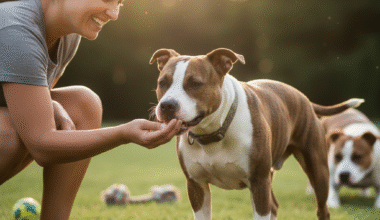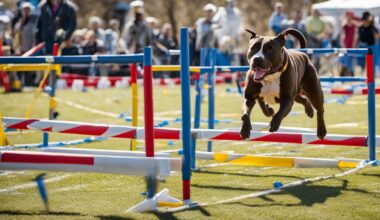Nearly 70% of pitbull owners report facing challenges with training in the first few months. If you’re a new owner, you’re not alone. Pitbulls are smart and loyal, but they can also be a bit stubborn. That’s why having a solid plan from the start makes a big difference.
In this Pitbull 101 training guide, you’ll learn practical tips that will help you tackle common issues like leash pulling, recall, and socializing your pup with confidence. Stick around until the end and you’ll pick up some simple but effective tricks to make training your new best friend easier.
Understanding the Pitbull Breed
Pit bulls are known for their strong, loyal personalities. This breed can be highly affectionate and stubborn, making early puppy training essential. Knowing their temperament helps you tailor your approach and focus on consistency.
Despite common myths, pit bulls are not naturally aggressive dogs. With the right guide and a clear training schedule, they can be well-behaved family pets. Training should emphasize obedience and socialization to teach pit bulls how to interact with other dogs and people.
Pitbull 101 Training Guide For Beginners

1. Start Puppy Training Early
Starting early is key to successful pitbull training. The sooner you establish a routine, the easier it is to manage your dog’s behavior as they grow. Setting a clear puppy training schedule with regular sessions helps reinforce commands like “sit,” “stay,” and “come.” These basics lay the foundation for long-term obedience.
Pitbulls respond best to short, engaging training sessions. Keep each session between 10-15 minutes to hold their attention, and always end on a positive note. Consistent use of commands and rewards will help your pitbull learn quickly.
Remember, patience and persistence are key during these early stages. Stick to your training routine, using positive reinforcement to reward good behavior. The effort you put in now will pay off in the long run, reducing behavioral problems and setting your dog up for success.
2. Leash Training and Walking Tips
Leash training your pitbull is crucial for enjoyable walks. Pit bulls can be strong and may pull if not trained properly. Start by introducing the leash early, letting your puppy get used to it before you begin actual walks. Use short, daily sessions to train them to walk calmly without pulling.
When training, use a firm but gentle approach. If your pitbull starts to pull, stop walking and wait for them to settle before continuing. This teaches them that pulling won’t get them anywhere.
Regular exercise is vital for pitbulls, and walks are a great way to keep them fit and happy. Consistent leash training, combined with enough physical activity will help reduce excess energy and prevent unwanted behaviors. If you’re facing difficulties, there are training products, like no-pull harnesses, that can make the process smoother.
3. Socialization and Obedience Training

Socializing your pitbull early is essential for preventing behavioral issues. Introduce your puppy to different environments, dogs, and people from a young age. Proper socialization helps reduce aggression and makes your pitbull more comfortable in various situations.
Obedience training goes hand-in-hand with socialization. Clear, consistent commands help your pitbull understand expectations, building trust between you and your dog. Training should be consistent to ensure long-term obedience and improve how they respond to different situations.
Avoid harsh punishments, as they can create fear or confusion. With patience, you’ll train a well-mannered pitbull who listens and interacts confidently with others. Keep the interactions positive, using treats and praise to reinforce good behavior.
4. Potty Training Your Pitbull
Potty training is the process of teaching your dog, usually a puppy, where and when it’s appropriate to relieve themselves. For pitbull puppies, this means training them to go outside to use the bathroom at specific times rather than inside the house.
The goal is to establish a routine where your pitbull understands when and where to go to the toilet, reducing accidents indoors. Potty training is one of the first challenges new pitbull owners face. Start by establishing a regular schedule for bathroom breaks, taking your puppy outside after meals, naps, and playtime.
To make potty training easier, use clear commands like “go potty” when you take them outside. This creates an association between the command and the action. If accidents happen indoors, don’t punish your pitbull—just calmly take them outside to the correct spot.
Several products can help with potty training, such as puppy pads or odor-neutralizing cleaners for accidents. Keep in mind that pitbulls respond well to routine, so sticking to a consistent potty schedule will reduce the chances of accidents.
5. Exercise and Mental Stimulation
Mental stimulation is just as important as physical exercise for pitbulls. Puzzle toys and games like hide-and-seek challenge their minds and reduce boredom. A bored pitbull is more likely to develop bad habits, so keeping their brain engaged is key.
Pitbulls also enjoy games that combine both physical and mental stimulation, like fetch or tug-of-war. These activities not only help reduce excess energy but also strengthen the bond between you and your dog. Aim for at least 30-60 minutes of physical activity each day to keep your pitbull in shape and well-behaved.
6. Online Resources and Products to Help with Training
If you’re struggling with training your pitbull, there are plenty of online guides and resources available to help. Many websites offer free and paid courses tailored to pitbulls. These online tools can provide you with structured training plans, making it easier to stay consistent and track progress.
Training products like no-pull harnesses, long leashes, and treat-dispensing toys can make a big difference during training.
No-Pull Harness
A no-pull harness is a great tool for leash training. It redirects your pitbull’s energy when they pull, making walks more manageable. This product helps teach your dog to walk calmly without straining against the leash.
Long Leash
Long leashes are useful for practicing recall training and allowing your pitbull more freedom to roam while still being under control. It’s a great product for reinforcing commands like “come” in a controlled environment, especially in open spaces.
Treat-Dispensing Toys
These toys not only provide mental stimulation but also reward your dog for engaging in the activity. Treat-dispensing toys encourage focus and can be used to reinforce good behavior during training sessions.

Conclusion
Training your pitbull takes time, patience, and consistency, but the results are well worth the effort. From leash training to teaching basic commands, each step in this Pitbull 101 training guide helps build a strong foundation for a well-behaved dog. Stick to a routine and use positive reinforcement to encourage good behavior.
Remember that pitbulls thrive on both physical exercise and mental stimulation. A balanced approach to training, with plenty of walks, games, and socialization, will help reduce behavioral issues and keep your pitbull happy.
By using the right tools, products, and resources, you’ll set your pitbull up for success. Training can be challenging, but with a clear plan and the right support, you’ll raise a loyal and well-mannered companion. Your efforts today will pay off in a confident, obedient pitbull tomorrow.







1 comment
l94j8f